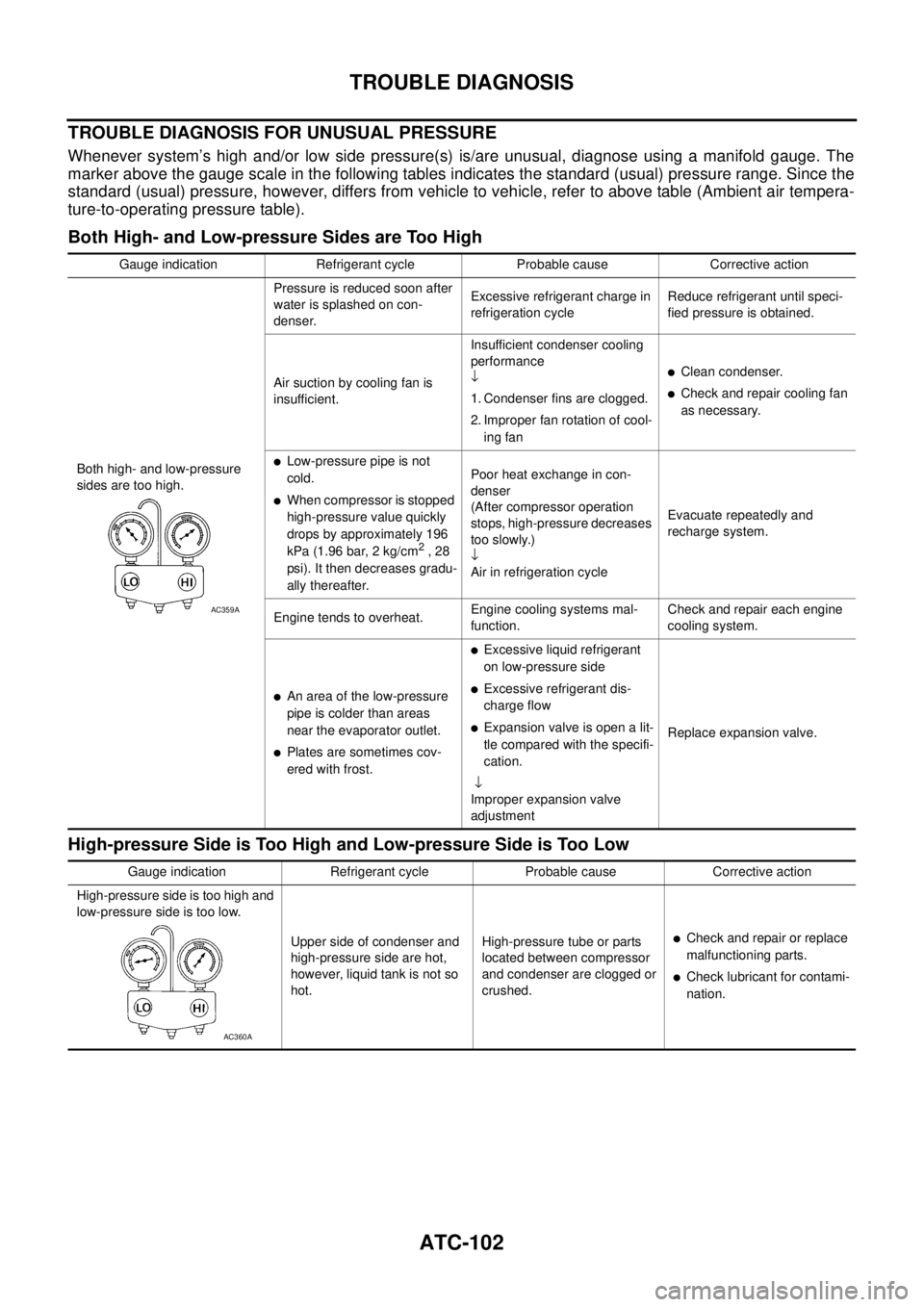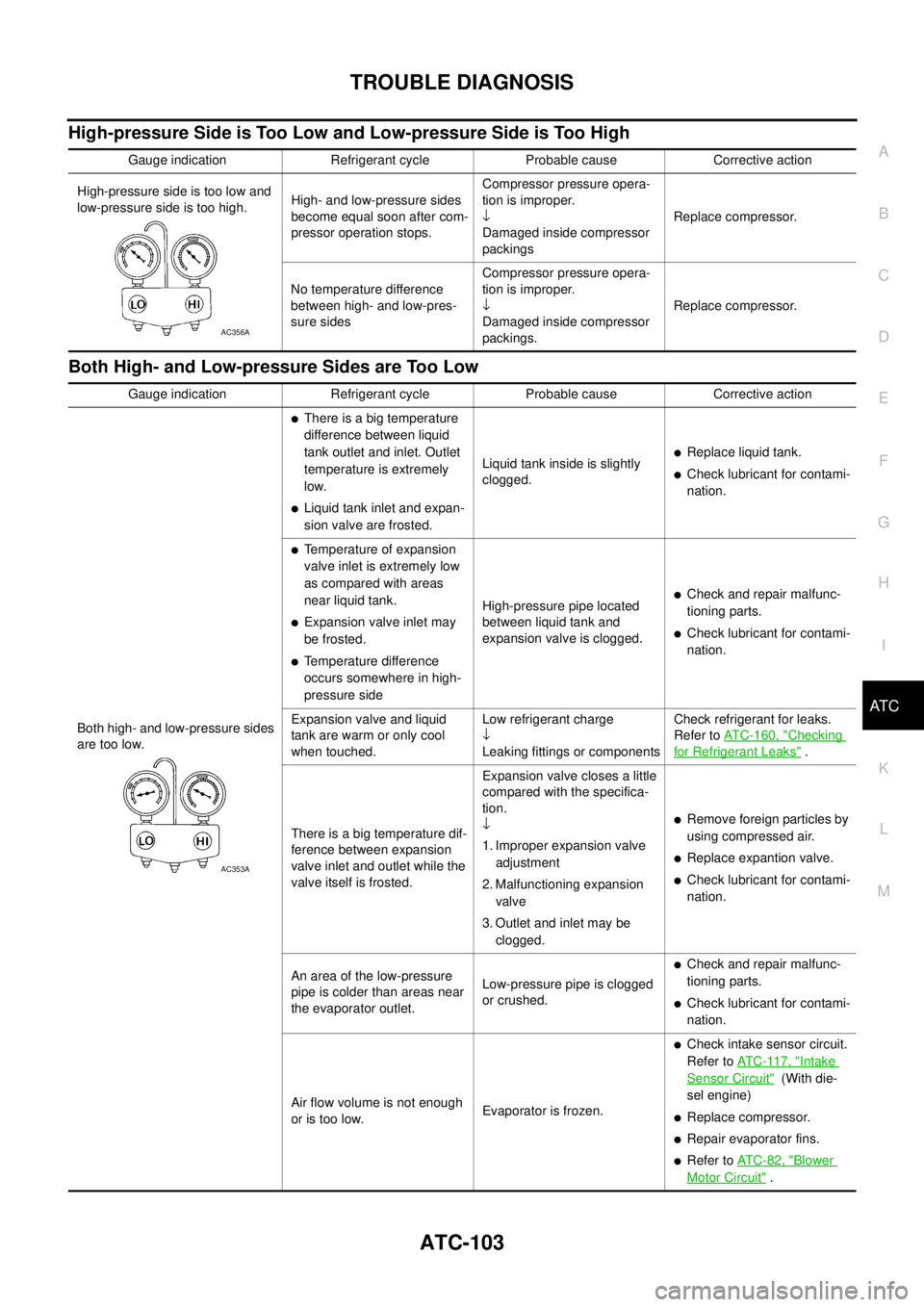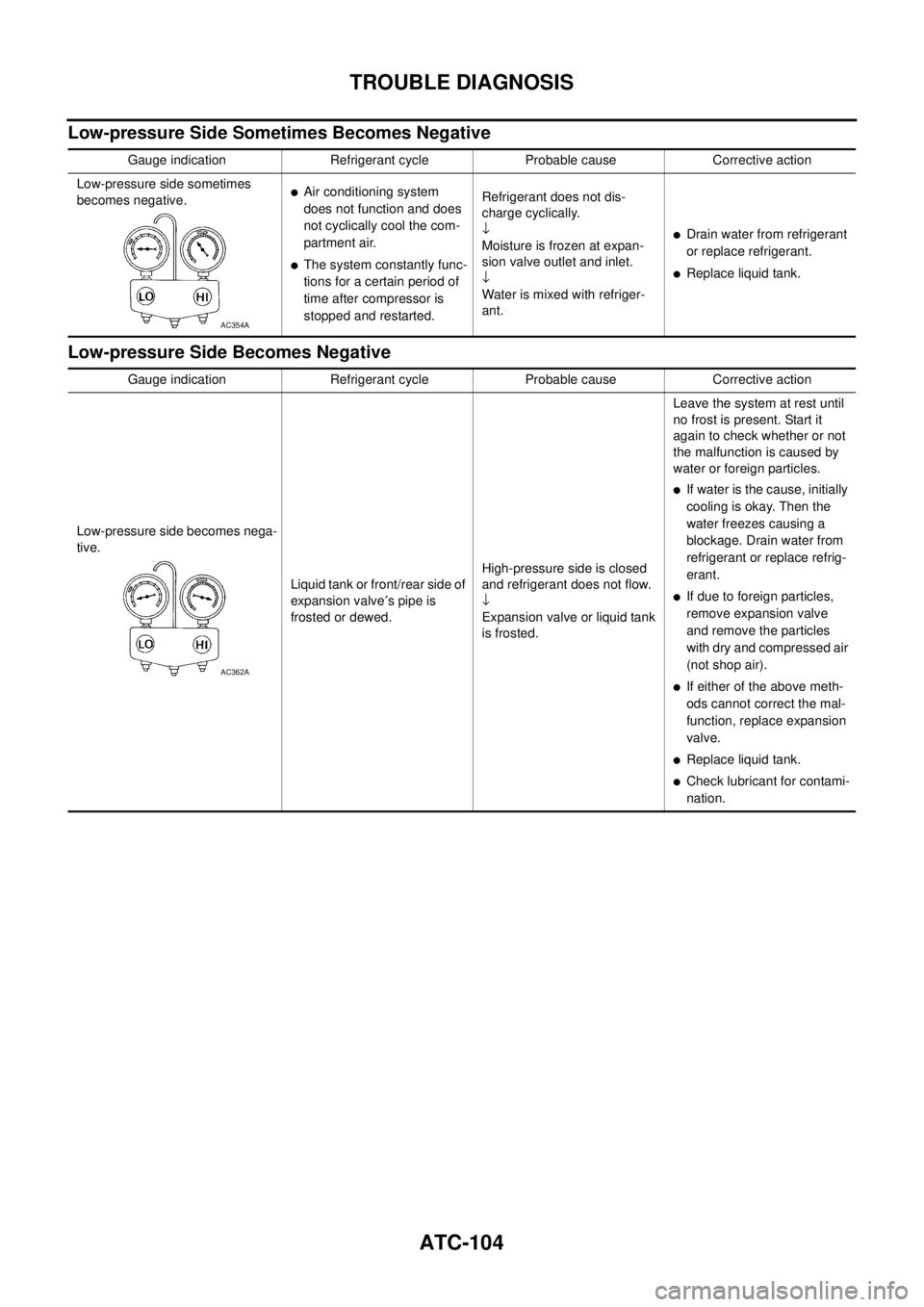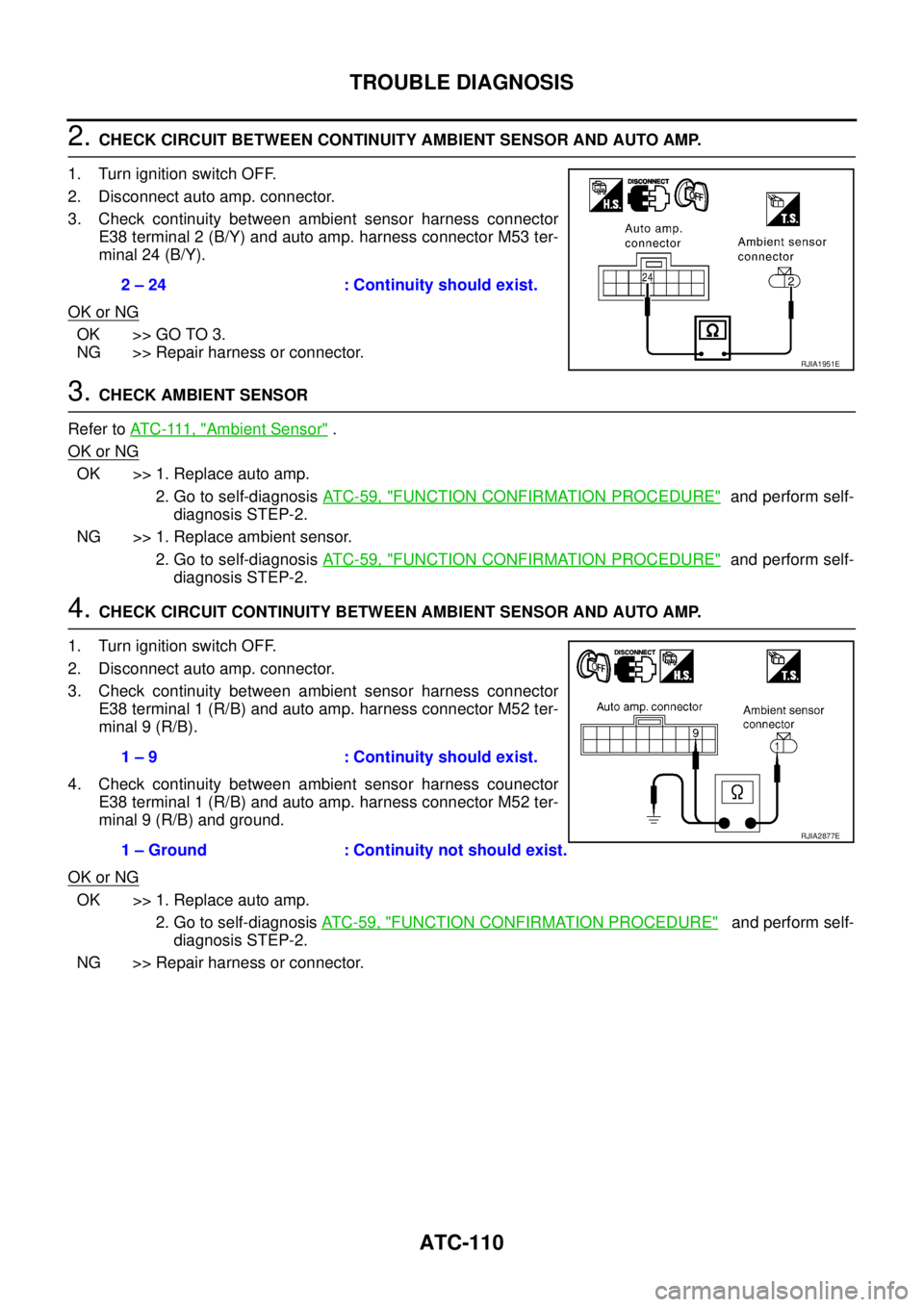Page 3277 of 4555
TROUBLE DIAGNOSIS
ATC-99
C
D
E
F
G
H
I
K
L
MA
B
AT C
*1ATC-146, "Removal and Installation
of Compressor Clutch".*2 AT C - 8 2 , "
Blower Motor Circuit" . *3 QR engine; EM-13, "Checking Drive
Belts" or YD engine; EM-140,
"Checking Drive Belts" .
RJIA3107E
Page 3280 of 4555

ATC-102
TROUBLE DIAGNOSIS
TROUBLE DIAGNOSIS FOR UNUSUAL PRESSURE
Whenever system’s high and/or low side pressure(s) is/are unusual, diagnose using a manifold gauge. The
marker above the gauge scale in the following tables indicates the standard (usual) pressure range. Since the
standard (usual) pressure, however, differs from vehicle to vehicle, refer to above table (Ambient air tempera-
ture-to-operating pressure table).
Both High- and Low-pressure Sides are Too High
High-pressure Side is Too High and Low-pressure Side is Too Low
Gauge indication Refrigerant cycle Probable cause Corrective action
Both high- and low-pressure
sides are too high.Pressure is reduced soon after
water is splashed on con-
denser.Excessive refrigerant charge in
refrigeration cycleReduce refrigerant until speci-
fied pressure is obtained.
Air suction by cooling fan is
insufficient.Insufficient condenser cooling
performance
↓
1. Condenser fins are clogged.
2. Improper fan rotation of cool-
ing fan
�Clean condenser.
�Check and repair cooling fan
as necessary.
�Low-pressure pipe is not
cold.
�When compressor is stopped
high-pressure value quickly
drops by approximately 196
kPa (1.96 bar, 2 kg/cm
2 , 28
psi). It then decreases gradu-
ally thereafter.Poor heat exchange in con-
denser
(After compressor operation
stops, high-pressure decreases
too slowly.)
↓
Air in refrigeration cycleEvacuate repeatedly and
recharge system.
Engine tends to overheat.Engine cooling systems mal-
function.Check and repair each engine
cooling system.
�An area of the low-pressure
pipe is colder than areas
near the evaporator outlet.
�Plates are sometimes cov-
ered with frost.
�Excessive liquid refrigerant
on low-pressure side
�Excessive refrigerant dis-
charge flow
�Expansion valve is open a lit-
tle compared with the specifi-
cation.
↓
Improper expansion valve
adjustmentReplace expansion valve.
AC359A
Gauge indication Refrigerant cycle Probable cause Corrective action
High-pressure side is too high and
low-pressure side is too low.
Upper side of condenser and
high-pressure side are hot,
however, liquid tank is not so
hot.High-pressure tube or parts
located between compressor
and condenser are clogged or
crushed.
�Check and repair or replace
malfunctioning parts.
�Check lubricant for contami-
nation.
AC360A
Page 3281 of 4555

TROUBLE DIAGNOSIS
ATC-103
C
D
E
F
G
H
I
K
L
MA
B
AT C
High-pressure Side is Too Low and Low-pressure Side is Too High
Both High- and Low-pressure Sides are Too Low
Gauge indication Refrigerant cycle Probable cause Corrective action
High-pressure side is too low and
low-pressure side is too high.High- and low-pressure sides
become equal soon after com-
pressor operation stops.Compressor pressure opera-
tion is improper.
↓
Damaged inside compressor
packingsReplace compressor.
No temperature difference
between high- and low-pres-
sure sidesCompressor pressure opera-
tion is improper.
↓
Damaged inside compressor
packings.Replace compressor.
AC356A
Gauge indication Refrigerant cycle Probable cause Corrective action
Both high- and low-pressure sides
are too low.
�There is a big temperature
difference between liquid
tank outlet and inlet. Outlet
temperature is extremely
low.
�Liquid tank inlet and expan-
sion valve are frosted.Liquid tank inside is slightly
clogged.
�Replace liquid tank.
�Check lubricant for contami-
nation.
�Temperature of expansion
valve inlet is extremely low
as compared with areas
near liquid tank.
�Expansion valve inlet may
be frosted.
�Temperature difference
occurs somewhere in high-
pressure sideHigh-pressure pipe located
between liquid tank and
expansion valve is clogged.
�Check and repair malfunc-
tioning parts.
�Check lubricant for contami-
nation.
Expansion valve and liquid
tank are warm or only cool
when touched.Low refrigerant charge
↓
Leaking fittings or componentsCheck refrigerant for leaks.
Refer to ATC-160, "
Checking
for Refrigerant Leaks" .
There is a big temperature dif-
ference between expansion
valve inlet and outlet while the
valve itself is frosted.Expansion valve closes a little
compared with the specifica-
tion.
↓
1. Improper expansion valve
adjustment
2. Malfunctioning expansion
valve
3. Outlet and inlet may be
clogged.
�Remove foreign particles by
using compressed air.
�Replace expantion valve.
�Check lubricant for contami-
nation.
An area of the low-pressure
pipe is colder than areas near
the evaporator outlet.Low-pressure pipe is clogged
or crushed.
�Check and repair malfunc-
tioning parts.
�Check lubricant for contami-
nation.
Air flow volume is not enough
or is too low.Evaporator is frozen.
�Check intake sensor circuit.
Refer to AT C - 11 7 , "
Intake
Sensor Circuit" (With die-
sel engine)
�Replace compressor.
�Repair evaporator fins.
�Refer to AT C - 8 2 , "Blower
Motor Circuit" .
AC353A
Page 3282 of 4555

ATC-104
TROUBLE DIAGNOSIS
Low-pressure Side Sometimes Becomes Negative
Low-pressure Side Becomes Negative
Gauge indication Refrigerant cycle Probable cause Corrective action
Low-pressure side sometimes
becomes negative.
�Air conditioning system
does not function and does
not cyclically cool the com-
partment air.
�The system constantly func-
tions for a certain period of
time after compressor is
stopped and restarted.Refrigerant does not dis-
charge cyclically.
↓
Moisture is frozen at expan-
sion valve outlet and inlet.
↓
Water is mixed with refriger-
ant.
�Drain water from refrigerant
or replace refrigerant.
�Replace liquid tank.
AC354A
Gauge indication Refrigerant cycle Probable cause Corrective action
Low-pressure side becomes nega-
tive.
Liquid tank or front/rear side of
expansion valve′s pipe is
frosted or dewed.High-pressure side is closed
and refrigerant does not flow.
↓
Expansion valve or liquid tank
is frosted.Leave the system at rest until
no frost is present. Start it
again to check whether or not
the malfunction is caused by
water or foreign particles.
�If water is the cause, initially
cooling is okay. Then the
water freezes causing a
blockage. Drain water from
refrigerant or replace refrig-
erant.
�If due to foreign particles,
remove expansion valve
and remove the particles
with dry and compressed air
(not shop air).
�If either of the above meth-
ods cannot correct the mal-
function, replace expansion
valve.
�Replace liquid tank.
�Check lubricant for contami-
nation.
AC362A
Page 3284 of 4555
ATC-106
TROUBLE DIAGNOSIS
*1AT C - 6 5 , "Operational Check".*2ATC-59, "FUNCTION CONFIRMA-
TION PROCEDURE", see No. 1.*3ATC-59, "
FUNCTION CONFIRMA-
TION PROCEDURE", see No. 5 to 7.
*4 QR engine: CO-9, "
Changing
Engine Coolant" or YD engine: CO-
32, "Changing Engine Coolant" .*5 QR engine; CO-13, "
Checking Radi-
ator Cap" or YD engine; CO-36,
"Checking Radiator Cap" .*6 QR engine; (WITH EURO-OBD) EC-
165, "DTC P0117, P0118 ECT SEN-
SOR" .
QR engine; (WITHOOUT EURO-
OBD) EC-652, "
DTC P0117, P0118
ECT SENSOR" .
YD engine; (WITH EURO-OBD) EC-
1093, "DTC P0117, P0118 ECT
SENSOR" .
YD engine; (WITHOUT EURO-OBD)
EC-1449, "
DTC P0117, P0118 ECT
SENSOR" .
*7AT C - 5 9 , "
FUNCTION CONFIRMA-
TION PROCEDURE", see No. 9.*8ATC-69, "
LAN System Circuit".*9ATC-82, "Blower Motor Circuit".
*10AT C - 7 6 , "
Air Mix Door Motor Cir-
cuit".
Page 3286 of 4555
ATC-108
TROUBLE DIAGNOSIS
Self-DiagnosisEJS004H5
SYMPTOM: Self-diagnosis cannot be performed.
INSPECTION FLOW
*1 Compressor clutch ATC-146,
"REMOVAL" .*2 Compressor clutch ATC-150, "INSTALLATION" .*3AT C - 2 4 , "
Maintenance of Lubricant
Quantity in Compressor".
*4ATC-65, "
Operational Check". *5 QR engine; EM-13, "Checking Drive
Belts" or YD engine; EM-140,
"Checking Drive Belts" .
*1ATC-65, "
Operational Check".*2ATC-67, "Power Supply and Ground
Circuit for Auto Amp.".*3AT C - 3 4 , "
SYMPTOM TABLE".
RJIA3109E
Page 3287 of 4555

TROUBLE DIAGNOSIS
ATC-109
C
D
E
F
G
H
I
K
L
MA
B
AT C
Ambient Sensor CircuitEJS004YP
COMPONENT DESCRIPTION
Ambient Sensor
The ambient sensor is attached on the hood lock stay. It detects
ambient temperature and converts it into a resistance value which is
then input into the auto amp.
AMBIENT TEMPERATURE INPUT PROCESS
The auto amp. includes a processing circuit for the ambient sensor input. However, when the temperature
detected by the ambient sensor increases quickly, the processing circuit retards the auto amp. function. It only
allows the auto amp. to recognize an ambient temperature increase of 0.33°C (0.6°F) per 100 seconds.
As an example, consider stopping for a few minutes after high speed driving. Although the actual ambient tem-
perature has not changed, the temperature detected by the ambient sensor will increase. This is because the
heat from the engine compartment can radiate to the front grille area, location of the ambient sensor.
DIAGNOSTIC PROCEDURE FOR AMBIENT SENSOR
SYMPTOM: Ambient sensor circuit is open or shorted.
LED of A/C switch does not illuminate as a result of performing self-
diagnosis STEP-2.
1. CHECK VOLTAGE BETWEEN AMBIENT SENSOR AND GROUND
1. Disconnect ambient sensor connector.
2. Turn ignition switch ON.
3. Check voltage between ambient sensor harness connector E38
terminal 1 (R/B) and ground.
OK or NG
OK >> GO TO 2.
NG >> GO TO 4.
RJIA0048E
RHA051GD
1 – Ground : Approx. 5V
RJIA2017E
Page 3288 of 4555

ATC-110
TROUBLE DIAGNOSIS
2. CHECK CIRCUIT BETWEEN CONTINUITY AMBIENT SENSOR AND AUTO AMP.
1. Turn ignition switch OFF.
2. Disconnect auto amp. connector.
3. Check continuity between ambient sensor harness connector
E38 terminal 2 (B/Y) and auto amp. harness connector M53 ter-
minal 24 (B/Y).
OK or NG
OK >> GO TO 3.
NG >> Repair harness or connector.
3. CHECK AMBIENT SENSOR
Refer to AT C - 111 , "
Ambient Sensor" .
OK or NG
OK >> 1. Replace auto amp.
2. Go to self-diagnosis AT C - 5 9 , "
FUNCTION CONFIRMATION PROCEDURE" and perform self-
diagnosis STEP-2.
NG >> 1. Replace ambient sensor.
2. Go to self-diagnosis AT C - 5 9 , "
FUNCTION CONFIRMATION PROCEDURE" and perform self-
diagnosis STEP-2.
4. CHECK CIRCUIT CONTINUITY BETWEEN AMBIENT SENSOR AND AUTO AMP.
1. Turn ignition switch OFF.
2. Disconnect auto amp. connector.
3. Check continuity between ambient sensor harness connector
E38 terminal 1 (R/B) and auto amp. harness connector M52 ter-
minal 9 (R/B).
4. Check continuity between ambient sensor harness counector
E38 terminal 1 (R/B) and auto amp. harness connector M52 ter-
minal 9 (R/B) and ground.
OK or NG
OK >> 1. Replace auto amp.
2. Go to self-diagnosis AT C - 5 9 , "
FUNCTION CONFIRMATION PROCEDURE" and perform self-
diagnosis STEP-2.
NG >> Repair harness or connector.2 – 24 : Continuity should exist.
RJIA1951E
1 – 9 : Continuity should exist.
1 – Ground : Continuity not should exist.
RJIA2877E